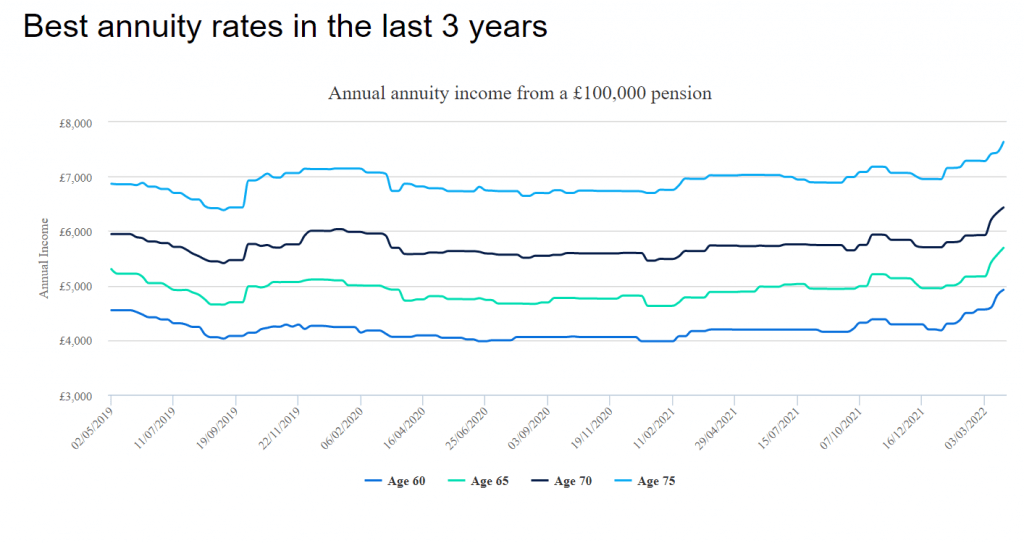What’s Going On?
The start of 2022 has seen some big changes in financial markets reacting to the end of the pandemic, war in Eastern Europe and Central Banks in the US and UK starting to tighten their monetary policy.
Risk Free Interest Rates Have Risen
Conventional UK Gilts are down around 8% so far in 2022, with the 20-year yield rising from a low of around 0.95% at the end of 2021 to just over 2% today. This is still very low by any historical measure.
Last week, the Bank of England raised base rates again to 1% and controversially against the worst household income squeeze in 40 years.
Rising rates will impact borrowing costs on mortgages and corporate debt, but also see a return to modest interest payments on cash deposits. New UK banking entrant Chase (subsidiary of JP Morgan) is offering 1.5% interest on cash deposits up to £250,000.
Rate rises are also starting to push up annuity rates. The chart below shows an almost 25% increase in level annuity rates for a 60-year-old in the last few months.
Our pension pots may have gone down this year, but their ability to generate risk-free income has gone up.

The US Dollar Has Strengthened
The US dollar remains the safe haven currency and the pound is down over 10% against the dollar in 2022.
This situation increases the value of our foreign investments that are denominated in dollars and our costs when we travel to dollar-based countries or import their goods.
The pound is relatively unchanged against the Euro. This suggests that it is not so much the pound weakness as the dollar strength.
This result comes on the back of higher interest rates in the US and a perceived stronger economy with less fallout from the Russia-Ukraine conflict.

Company Valuations (But Not Earnings) Have Decreased
The MSCI World index is down around 17% so far in 2022, in US dollar terms, and about 9% in sterling terms, which has lessened the impact of these losses in portfolios.
This drop needs to be seen in the context of some very highly valued US stocks which dominate the US and World indices.
Not all share prices have been falling. By contrast the FTSE100, a good proxy for value companies and benefiting from the decline in the pound, is down only 0.5%.
Read what Dundas Global Investors, managers of Heriot Global have to say on this.
“Firstly, out of the 69 companies in the portfolio, 30 reported in Q1 with the average dividend increase being 22.6%. This is very much at odds with the stock market sentiment more generally. Furthermore, 41 companies have increased their margins this year and our anticipated growth rate has increased to 13.2% vs. the market 8.5%*. Far from taking a negative view on the market, Dundas believe stocks have just got cheaper.”
“The Nasdaq is down 27% from its record high – there’s a big divergence in performance – Netflix down 72%, Meta down 45%, Amazon down 42% whilst Apple “only down” 14%, Google down 22%, Microsoft down 20% - we own Apple, Google & Microsoft. We believe this points to a stock pickers environment.”
*Source: Dundas Global Investors 10/5/2022
How Are Tideway Clients Fairing?
Of course, your portfolio returns will depend on how you are invested with us.
Our Multi Asset Balanced Portfolio is down around 8% year to date and pretty much in line with its peers in terms of falls this year, having outperformed in the previous few years.
These price falls have masked a large dispersion of returns between both funds and asset classes.
In descending order of year-to-date performance:
- Our Equity Income portfolio (E1) is the strongest portfolio, under pinned by a great return from the Schroder Global Equity Income fund, up around 4% year to date. The portfolio has returned –1% YTD
- Our Alternative funds have also held up relatively well as a whole; Franklin Templeton Global Infrastructure is up 11% for the year, Ruffer Diversified Return is up 4% (though this has only been held since March), Sanlam Multistrategy is down 8%, whist Schroder Global Cities has had a tough couple of weeks with the return now down 11% year to date.
- Our Fixed Income portfolio has done less well than we would have hoped with the largest holding in the Sanlam Hybrid Capital fund down 11% year to date.
- Our Global Growth portfolio (E2) is the worst hit, down 15% with funds like Ballie Gifford Global Alpha down 25% and our Montanaro Better World smaller companies fund down 31%, which is deliberately one of our smallest allocations in all portfolios.
We spent some time at Sanlam last week with the fixed income team to get the latest Hybrid fund performance.
Main takeaways:
- We did not see anything that concerned us too much other than the concentration of the portfolio, which remains high. This is something we have discussed with the team in the past and will continue to monitor.
- Importantly, they have not crystalised big losses and some of the bonds in the portfolio are now yielding around 7%, a big increase from the end of last year.
- The team are not concerned about the credit worthiness of the bond issuers and believe there to be significant up-side now in the portfolio.
- As ever, when markets get risk-averse the liquidity in the types of bonds this fund holds is poor and sellers are punished.They are not selling bonds and with new investors coming into the fund they get to buy new bonds at more attractive rates.
Whilst the fund fell in line with equity markets initially in the year, falls in values in recent weeks have been considerably lower as the yields underpin values as you would expect.
We see that with these yields the coupon income alone will restore the fund to its late 2021 highs in less than 2 years.
This is a big contrast to the 8.25% drop in gilts which in income alone would take more than 4 years to restore.
Finally, in our daily dealings with clients, we do get to see the returns of other wealth managers and can see that some quite big names have not protected capital as well as Tideway.
Wealth Managers adopting more of an index approach, or with bigger growth equity positions have seen bigger equity losses. Those with exposure to treasuries rather than our corporate bonds in fixed income will likely have much longer to wait to get back to a profit.
Our Outlook
As ever we are not trying to bet too heavily on what happens next.
Equity market valuations are becoming more attractive. Like compressing a big spring, the further down you push prices the larger the bounce back will be when it comes.
We can say is that from here portfolio returns should be higher in the long term than from the start of the year. On a five to 10 year view we will end up in the same place!
If the fear of recessions outweighs that of inflation, bond yields could stop rising and central banks might even start easing again.
Equally we can see that wage increases are happening and commodity prices, energy costs and inflation could stay high for a while.
We are sufficiently diversified to cope with either outcome. We have made changes to be more defensive, rewarding managers that have been doing well and trimming those which haven’t.
The relative price movements in the portfolios as shown above have also done this naturally and will continue to do that if current trends persist. We are ready to rebalance if we see things changing.
- The content of this document is for information purposes only and should not be construed as financial advice
- Please be aware that the value of investments, and the income you may receive from them, cannot be guaranteed and may fall as well as rise
- We always recommend that you seek professional regulated financial advice before investing
